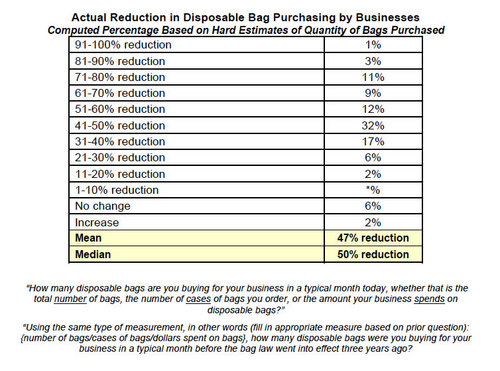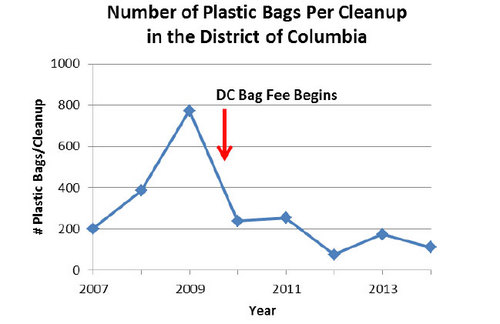The data proves the DC bag fee is working

Photo by the author
DC’s bag fee has been a success, despite the insinuations and inaccuracies in a recent Washington Post “expose.” Plenty of numbers say we’re using fewer bags because of the fee.
The article’s authors point to a handful of data points to make the case that the five-cent fee on plastic bags isn’t cutting bag usage in the District. But they mischaracterized or took a lot of it out of context, and they simply ignored additional data that contradicted their headline-grabbing argument.
According to several independent studies, in less than five years and for a cost of $.05 per bag, bag usage in DC has dropped by more than 50%.
It’s tough to get a count on bag use, both past and present
It’s hard to measure how much bag use has gone down since the fee went into place in 2010. Because the District didn’t study how many bags retail stores were distributing or assess how many bags residents used in a typical week before the fee, there is no exact baseline number.
To get a starting point, the Office of the Chief Financial Officer used on a 2004 Seattle study to estimate that DC used 270 million bags annually, or 465 bags per resident. Since DC’s daytime population tops one million, it’s reasonable to think the OCFO’s number is actually an underestimate.
And while DC could do a waste sort to estimate how many bags residents are using now, that’d be inexact as well, and we’d be left comparing an estimate to an estimate. It’s also unreliable to use revenue collected from the bag fee to assess the change in bag use, as compliance rates change, the District’s population has increased by more than 12%, and more than a dozen new grocery stores (among other retailers) have opened since 2010.
These numbers say bag use is way down
The Post article cites the 2013 OpinionWorks study, the product of a partnership between the District Department of the Environment, Alice Ferguson Foundation, and Anacostia Watershed Society. It used results of a survey that asked 600 residents across all eight wards how many bags they used per week before the fee took effect and compared the numbers to how many they use now.
Survey participants reported taking an average of ten bags per week before the fee, and only four bags now, a reduction of 60%.
The Post article did not include the rest of the study, which also included an extensive survey of 177 businesses subject to the bag fee, including both chains and independent stores, large and small, from across the city. Canvassers visited businesses, looked at receipts showing bag purchases before the fee and after, and reported the number of bags given to consumers. The survey found businesses reported giving out 50% fewer bags than before the fee.
The Post article claimed the Alice Ferguson Foundation overstated the drop in how many bag its volunteers for its annual Potomac River Watershed Cleanup have collected at DC cleanup sites since 2007. But after the article went to print, AFF staff reviewed its data and confirmed a 72% decrease in bags collected in the years before the fee versus after.
This reduction should be taken in context, as the counts are performed by volunteers and participation, weather conditions, and vegetation levels can change the counts from year to year. But even with that caveat, it is very noteworthy that the only jurisdictions with reductions in the number of bags collected during cleanups are the District and Montgomery County. Although the cleanups occur in several jurisdictions, these are the only two with bag fees.
Additional research yielded evidence that bag fees have influenced consumer behavior in the Washington region. In 2014, Sierra Club volunteers observed shoppers leaving chain grocery stores in the District, Montgomery County, and Prince George’s County.
Among 20,000 shoppers in all three places, 53% in DC and 57% in Montgomery County used at least one reusable bag, or no bag at all, to carry their purchases. Meanwhile, in Prince George’s County, which has no bag fee (despite years of trying), fewer than one in every ten shoppers had a reusable bag.
Whether they’re from self-reported experiences, observational data, or cleanup data, all the numbers show the same thing: bag fees encourage consumers to use far fewer plastic bags.
The Anacostia River has a long way to go before it’s fully healthy, and plastic bags are far from the only pollution problem. But charging a nickel to get people to think twice about using a plastic bag has proved to be a valuable tool for kickstarting the river’s restoration.




